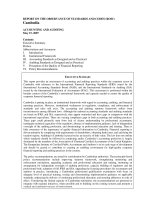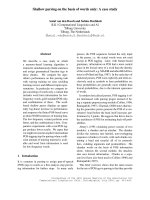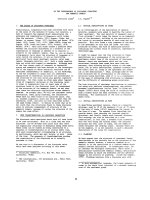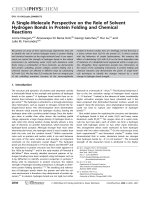On the Commercialisation of Accountancy Thesis: A review Essay docx
Bạn đang xem bản rút gọn của tài liệu. Xem và tải ngay bản đầy đủ của tài liệu tại đây (79.13 KB, 12 trang )
On the Commercialisation of Accountancy Thesis: A review Essay
By
Prem Sikka
Department of Accounting and Financial Management
University of Essex, UK
Hugh Willmott
Judge Institute of Management
University of Cambridge, UK
A later version of this article appears in Accounting, Organizations and Society, 22, 8: 831-842
(1997)
For more information on published articles by Hugh Willmott please refer to
ON THE COMMERCIALIZATION OF ACCOUNTANCY THESIS:
A REVIEW ESSAY
by
Hugh Willmott
University of Manchester Institute of Science and Technology, UK.
Prem Sikka
University of Essex, UK.
1
ON THE COMMERCIALIZATION OF ACCOUNTANCY THESIS
ABSTRACT
Hanlon’s thesis on the commercialisation of accountancy is examined in relation to
contemporary changes in the organization of work and the concentration and
internationalization of the accounting industry. Attention is drawn to the tensions between
Hanlon’s empirical materials and his exegesis of theoretical debates. An appreciation of the
value of his book for highlighting the wider significance of accounting to a shift from Fordist to
more flexible forms of accumulation is balanced by a discussion of various limitations and
because in Hanlon’s analysis, including the neglect of non-audit business undertaken by
accounting firms and the sketchy treatment of the links between these firms and other key
players that have supported and legitimised the progressive commercialization of
accountancy.
The UK’s biggest six accountancy firms currently employ some 44,000 people, and have seen
their income rise from
347 million in 1982 to around
2,800 million in 1995 (The Accountant,
August 1995, page 12). The expansion of consultancy and non-audit work has been a major
element in the growth of accountancy firms, and this work now forms more than 50% of their
income (The Accountant, August 1995, page 14). The influence of the firms is not just
confined to the commercial sector but now extends to health, transport, diplomatic services,
local government, defence, education and other arenas (Accountancy Age, 18 August 1994,
page 3; 13 October 1994, page 1; 26 October 1995, page 1; 23 November 1995, page 1).
Given the scale and influence of these ‘world’ accountancy firms, their operations are
remarkably under-researched. Seemingly, social scientists have found other established and
prestigious (or, at least, less numerate and grey) occupations, such as medicine or law, more
conducive and perhaps more accessible fields of study. Moreover, when accountancy has
been studied, the focus has tended to be upon processes of professionalization (e.g. Loft,
1986; Firms, 1985), rather than upon the organization of work undertaken by accounting firms
or the involvement of accountants and accounting in the reproduction or transformation of
capitalist relations of production
[1]
.
[1]
. The obvious exceptions to this rule are the writings of Terence Johnson and Peter Armstrong (reviewed by Hanlon on pp.
2
Hanlon’s (1994) study
[2]
is valuable because it seeks to place and understand the changing
nature of accountancy within a bigger picture of the dynamics of politico- economic
development. It explores how the organisation, control, and ideological outlook of accountants
has altered with the emergence and entrenchment of the new regime of flexible accumulation
(Harvey, 1989). In common with a number of other studies (e.g. Johnson, 1980; Tinker, 1985;
Puxty, 1990; Roslender, 1992), Hanlon invites us to reflect upon contemporary changes in the
practice of accountancy in the context of a shift from a Fordist to a more flexible regime of
accumulation (Ch.1). Situating his analysis within a broadly Marxian problematic, Hanlon
argues that the ‘ commercialization of accountancy’ is a medium as well as an outcome of this
shift. Stimulated by a crisis in profitability, ‘capital’ is understood to have ‘hit back and regained
some of the losses it suffered under the Fordist regime’ (p.219) - a process in which
accountancy firms have actively participated by placing increasing emphasis upon the
commercial acumen of their staff. It is this acumen, rather than the reliability, honesty or even
the technical ability of the firms’ staff, Hanlon argues, that is increasingly the primary measure
of their trustworthiness. This is well illustrated in the following quotation:
a firm like ours is a commercial organization and the bottom line is that first of
all the individual must contribute to the profitability of the business. In part that
is bringing in business but essentially profitability is based upon the ability to
serve existing clients well (Big Six Director, quoted on p. 121).
The empirical focus of Hanlon’s research is upon the organization of the audit function and the
socialization of its staff rather than upon the interaction and influence of accountancy firms
with other powerful agencies of change (e.g. clients, politicians, government departments,
academics). Of course, historically audit has been ‘core business’ for accountancy firms. But
its contribution to accountancy firm revenues has been declining (Accountancy, July 1995,
pages 18-19); it is also of dubious relevance for understanding the role of accountants in
‘serving’ the shift to a new regime of flexible accumulation. More fundamentally, it has been
198-204) which, however, are primarily historical and theoretical in emphasis.
[2]
Unless stated otherwise, all subsequent references to Hanlon refer to his book.
3
questioned whether ‘Fordism’ was as inflexible as the advocates and commentators on
diverse formulations of ‘Flexibility’ claim (Williams et al,, 1992). But leaving that aside, it might
equally be argued that the organization of audit during the 1960’s and 1970’s was more
Flexible and less Fordist in the sense that the pressures towards specialization,
standardisation and routinization were not as intense as they are today
[3]
. Current moves
towards the substitution of accounting technicians for graduates, for example, which involve
training people to acquire only those skills that they require to do the task in hand, would seem
to be more Fordist than Flexible in inspiration.
Despite its explicit concern with the issue of flexible accumulation, Hanlon’s research actually
tells us much less about the role of accountants in the creation of such regimes than it reveals
about the impact of intensified competition between accountancy firms for audit business and
the growing importance of non-audit business as a source of revenue. From this alternative
perspective, evidence of an increasing emphasis upon a commercial orientation amongst audit
staff, as derived from Hanlon’s questionnaires and interviews, is interpreted as symptomatic of
the intensification of competition rather than as an articulation of any putative shift, to a more
flexible regime of accumulation; and, crucially, the importance of audit as a vehicle for
securing other, more lucrative, business. Audit provides an opening for accountancy firms to
impress their potential industrial and commercial employers with zeal about punctuality,
meeting deadlines, attention to detail, the value of surveillance, judgement, control and related
implications of cutting costs and inefficiency.
In defence of Hanlon’s exclusive and decontextualised focus upon audit, it might be argued
that any evidence of a shift towards greater commercialism in the supposedly ‘public interest
sphere’ of audit would be reflected and indeed magnified in other specialist areas. But this
argument is not made. Little rationale or explanation is offered by Hanlon for the exclusive
[3]
Many of the pressures for standardisation emerged with the state sponsored criticisms of the external audit function, as
evidenced by a number of reports from the Department of Trade and Industry (see, Sikka and Willmott, 1995a).
4
focus upon audit. More damaging, in terms of any concern to relate changes within
accountancy to the broader shifts in processes of accumulation, is the collection of data
[4]
about audit from junior accountants and partners
[5]
alone, to the exclusion of the involvement
of other parties - clients, politicians, accountancy bodies, other ‘professionals’ etc. - within
what, building upon Abbott (1988), might be characterised as the wider system of audit
practice and regulation (Sikka and Willmott, 1995b).
Despite these limitations, Hanlon’s study has many stimulating and valuable things to say. It
usefully draws together and contextualises data on the historical development of the firms
(Ch.2). It also provides additional information on the control processes experienced by the
comparatively low-level staff who work on audits. It fills some important gaps in our knowledge
of the organization, control and outlook of staff in accountancy firms - an ignorance that is not
greatly assisted by the minimal requirements for public disclosure and accountability applied to
partnerships
[6]
. But, most importantly perhaps, Hanlon’s study poses a challenge to academics
and practitioners to address the politico-economic significance of accounting by locating it,
however imperfectly, within
inter alia
broader debates about post-industrial society, the
organization and control of labour processes, the international division of labour and the
expansion of the commercial segment of the so-called service class. In this review, we first
explore Hanlon’s central thesis before highlighting some problems and lacunae in his analysis.
The Commercialization Thesis
Hanlon notes that there have always been tensions between what he characterises as ‘the
[4]
. Hanlon’s empirical data is drawn from questionnaires distributed to members of the Institute of Chartered Accountants in
Ireland (one with 400 accountants based in Ireland and another with 250 accountants based abroad) and 55 interviews
conducted with young accountants within practice and industry (24 in total) and with Big Six partners (31 in total).
[5]
Gender aspects are ignored by Hanlon (pages 33-34) even though they may be highly relevant to understanding socialization,
entry, promotion and control processes.
[6]
To counter the litigation threat, some major firms (e.g. KPMG) have now incorporated the auditing arm of their business and
will thus be forced to make some public disclosures.
5
"commercial" segment’ of firms (e.g. tax, management services, corporate finance, etc.) and
‘the "public-orientated" audit segment’ (p.108). But, in recent years, he contends, material and
ideological changes - notably, rhetoric and inducement to build an Enterprise Culture (see
Keat and Abercrombie, 1991) have fuelled the commercial ethos of the written audit segment.
It is this commercial ethos, Hanlon argues, that ‘is reflected in and has shaped the
socialization and control processes that accountants within practice experience’ (p.108).
Uninhibited by the need even to pay lip-service to a public interest ethos, firms more openly
promote ideals which encourage competitive individualism, with an emphasis on retaining
clients, pleasing the customer (i.e. capital) and promoting business virtues (pp 11-2). In
contrast to a decade or so ago, ‘Today, the emphasis is very firmly on being commercial and
on performing a service for the customer rather than being public spirited on behalf of either
the public or the state’ (p.150).
Following post-industrial theorists (e.g. Bell, 1973, 1976; Lash and Urry, 1987), Hanlon claims
that professional workers, such as accountants, have become dominant in shaping the
success of Western economies
[7]
. In post-industrial societies, the centre of gravity is
understood to be the production of knowledge and the processing of information rather than
(industrial) production of goods. In principle, post-industrial societies are populated by
professional, technical workers or the knowledge elites, who are concerned with production,
processing, dissemination and legitimation of information. Through the introduction of new
information and communication technologies and control and surveillance techniques,
employment in manufacturing shrinks as employment in ‘think work’, including accountancy,
expands. The power and influence of the new knowledge elites within this regime, Hanlon
argues, is exemplified in the field of accountancy : ‘Accountancy could be said to typify
Flexible Accumulation or at least the elite occupational aspects of this new structure of
accumulation. It is one of the fastest growing sectors of the advanced economies’ (p. 29). In
[7]
In contrast, Castells (1989) argues that what matters is the role and influence of information and technological change rather
than the dominance of the service economy.
6
the ‘flexible regime’, accountants are prized because accounting has become the ‘meta-
language of Flexible Accumulation and it is found in all areas of social activity from the stock
exchange to the hospital’ and through it ‘the cost of every individual relationship, every
individual person, and every individual action can be calculated’ (p. 31). However, as we noted
earlier, Hanlon’s empirical material sheds little, if any, light upon how accountancy firms
articulate and apply this ‘meta-language’.
The focus of post-industrial theories is upon the (changing)
content
of work. Hanlon, in
contrast, usefully stresses the continuation of capitalist relations of production. The demand for
accounting information is understood to be fuelled by the inherent instability and Shiva-like
dynamics of capitalist economies, as evidenced by a tendency for the rate of profit to fall and a
crisis of accumulation (O’Connor, 1987) prior to restructuring that, if successful, recharges the
cycle of investment. However, in Hanlon’s study, accountants are products or objects, not also
agents or subjects, of a shift from Fordism to a regime of flexible accumulation: ‘capital and
profit have shaped the service class, not vice versa’ (p. 219). Unless the restoration of
capitalism through this transformation is believed to be automatic, this is implausible. Efforts to
respond to periodic crises of accumulation are necessarily interpreted through, and mediated
by, cultural values and institutions, including those developed by members of the so-called
service class (see Smith and Willmott, 1996).
Commercial Imperialism
.
Internationally, [Western] commercial imperialism has supplemented, if not supplanted, military
imperialism. Accountancy multinationals have sought to establish global identities equivalent to
Coca-Cola or Macdonalds (Accountancy, March 1995, page 1). In what are the most original
chapters of the book, Hanlon usefully illustrates the process of commercial imperialism by
reference to the position of Irish accountants within the international division of accounting
labour (Chs 2 and 5). He notes how the ideology and practices of the big firms have been
developed within the Anglo-American context. As a consequence, offices located in peripheral
7
economies like Ireland enjoy a degree of autonomy ‘in all matters Irish’ (p.66) (e.g. number of
partners, targeting of clients, use of advertising, etc) but they are required to adhere to the
international standards laid down by the firms that are largely derived from the US and UK.
Key strategic decisions, such as those relating to mergers, are also dominated by US and UK
partners.
Senior members of the Irish constituency of the Big Six firms are shown to experience mixed
feelings about the process of concentration as it effectively weakens their capacity to influence
major decisions. However, despite the realistic possibility of opting out, since only 15% of their
business relied upon international connections, the advantages of concentration were
emphasised, as is indicated in the following quote:
85 per cent [of the work] is indigenous or from Irish companies so in that strict sense
it wouldn’t have been economic suicide but it wasn’t seriously considered. It would not
have made sense from a medium or long term point of view. Economically fine from
the 85 per cent of the Irish business (sic) but in terms of cutting ourselves off from
international developments, opportunities to send our staff overseas to gain the
benefits of professional standards and that, it would have been suicide (Big Six
Director, p. 67).
This observation illustrates the strength of the pull of the ‘ centre’ upon the ‘ periphery’. The
focus is upon the future prosperity of the firm as a business rather than upon retaining a
degree of local control over operations (e.g. over professional standards, see below).
‘Professional standards’ are increasingly identified with what happens elsewhere (at the
centre); and ‘opting out’ is equated with denying the opportunity to acquire experience
elsewhere - an opportunity that Hanlon later describes as ‘a fine piece of mystification’ since
‘whether one has been to London, Calcutta or Kingston is of little technical importance’
(p.216). Whilst opportunities to gain such experience do arise, becoming part of an
international firm has the consequence of drawing expertise from outside Ireland rather than
from another Irish accountancy practice capable of doing the work (p. 70).
8
As Hanlon persuasively argues, the progressive concentration of the accountancy industry into
six Big Firms, whose clients are the Big International Companies, reflects a more general,
contradictory trend towards monopoly within capitalist economies where the virtues of
competition are routinely extolled but, in reality, industries divide into big and small firms (pp99-
106) which serve different markets and adopt different practices (e.g. in respect of training).
Only the very biggest firms are capable of doing the biggest audits and providing the range of
consultancy services demanded by multinational companies (pp95-99). Due to their client
base, major firms are able to take advantages of economies of scale and employ specialists
whilst small firms cannot and are often forced to subcontract (or seek advice) specialist work
to major firms - with the attendant likelihood that the subcontracted work (and client) may be
poached. To ensure that the global ideologies and identities dominate, the firms have
international policy committees, consisting of representatives from national firms. Such
committees plan strategy and make global decisions, mergers, diversification and other global
decisions. Local firms are given considerable autonomy and discretion, but are subjected to
visits by a foreign partners who examine the work of the indigenous practice in light of the
global requirements.
It is not just the size and structure of the big firms that resembles the multinational companies.
It is also the acquisition of a commercial ethos which, for example, renders audit charges
increasingly subject to competitive forces that place pressures upon firms to find ways and
means of maintaining profitability by reducing the costs of undertaking the audit - most
dramatically evident in the practice of ‘low-balling’
[8]
. On the basis of his empirical data, Hanlon
claims that ‘because of constraints upon profitability’ ‘the senior’ responsible for overseeing
the audit ‘is not completely free to check a company’s accounts and ensure that the public
interest is being served as he or she is accountable to a superior ’(p.85, see also pp128-137).
Commercial pressures to expand the client base, to be profitable and to keep clients [capital]
[8]
Low-balling describes the practice of reducing the audit fee when tendering for new business in the hope or
expectation that the ‘loss leader’ will be compensated by the opportunity to attract other (e.g. non-audit business from
the audit client.
9
satisfied are the major requisites. By increasing the pool of accounting technicians who have
little or no prospect of becoming partners, the less routine work, within auditing and in
consultancy, continues to be reserved for the chartered accountant (see pp. 205-206). As
Hanlon speculates,
Whatever the future of auditing will be within these possible changes the policy will not
deskill the chartered accountant, rather the structure of the firm will be altered (p.93)
Hanlon argues that to deskill ‘core’ staff would be to risk damaging the reputation of firms, and
thus lose a major selling point. Thus, pressures to reduce the cost of audit by lowering staff
costs are balanced against the hazard of recruiting staff with less qualifications and/or limited
career prospects who ‘have not got the same "respect" for professionalism nor the same
ideological commitment to capitalism’ (p. 94). In sum, the training of accountants, Hanlon
indicates, is now primarily concerned with becoming commercially aware, trustworthy and
acceptable (to capital) rather than (exclusively) developing technical expertise or serving
‘public interest’ values. In this context, the connotation of trustworthiness shifts so that it
increasingly means trusted to privilege and defend commercial criteria.
Some Problems
Two Books or One?
Despite reservations about its framing, we find Hanlon’s commercialisation thesis broadly
plausible. We accept that the opportunities presented by Enterprise Culture have been
enthusiastically embraced and promoted by accountancy firms, especially their consultancy
arms which have played a key role in facilitating and legitimising restructuring initiatives within
the public and private sectors. However, Hanlon’s more grandiose claims and explorations of
theory seem to be have been developed independently of, or after, the questionnaire and
10
interview schedule were designed. For the focus and substance of the empirical data allows
comparatively little light to be shed upon the conjectured process of commercialization within
and between accountancy firms and the context of their operation. For example, the data do
not provide much information about how the training and appraisal of accountants has
changed over the past decade or so. And instead of exploring how accounting firms interact
with clients to attract and maintain different kinds of business and examining how this process
may have been affected by a more commercial ethos, Hanlon’s focus is upon the
organizational controls and incentive mechanisms that operate to make the demeanour of
accountants acceptable to clients, to standardize the audit process, and to render it profitable.
Hanlon’s focus upon the internal controls of audit within accountancy firms does not allow an
exploration of how accountants have been actively involved in advising and ‘educating’ their
clients, including government and public sector organizations, about how to adopt accounting
and other practices that, he suggests, are more consistent with a regime of flexible
accumulation. Hanlon repeatedly alludes to the importance of accountants in enabling
corporations to restructure their operations in a variety of ways (e.g. relocating production,
outsourcing, casualization, introducing more flexible working practices) - all of which, he
argues, share the objective of giving ‘ capital increased control and flexibility over labour’ (p.
18) as a means of restoring its profitability. He notes, for example, how major accountancy
firms ‘have expanded their product range areas such as tax, corporate finance, management
consultancy and so on grow’ (p. 110). He even goes so far as to suggest that whereas the
engineer is identified as the "ideal image" of Fordism, the accountant is viewed as ‘the key
image of Flexible Accumulation’ (p.31). But the focus of his data collection and his theorising of
that data (e.g. interviews with partners of the Big Firms) does not permit him to put empirical
flesh on these theoretical bones.
Theoretical Tensions
.
When criticising ‘ post-industrial’ and ‘ disorganized’ theories of change in late capitalist









